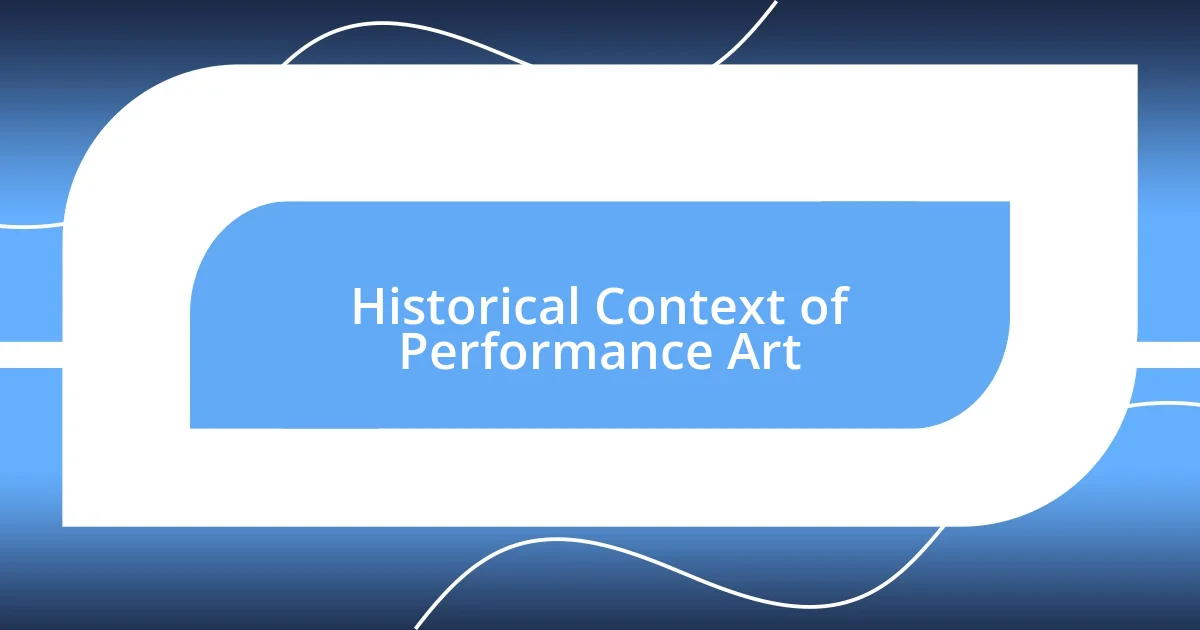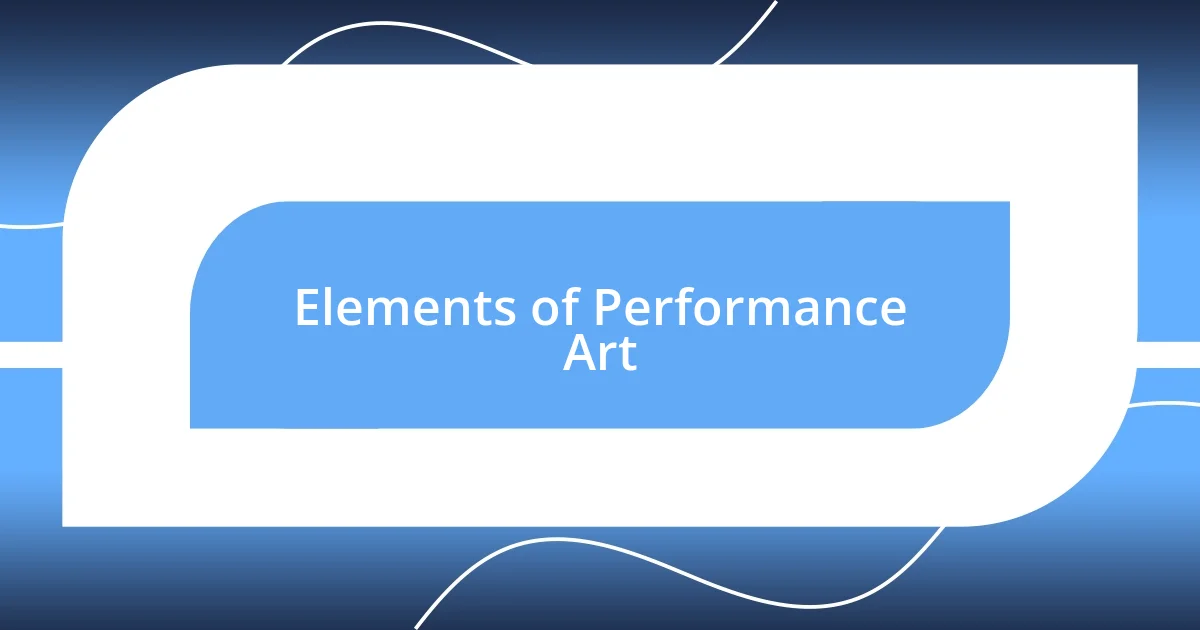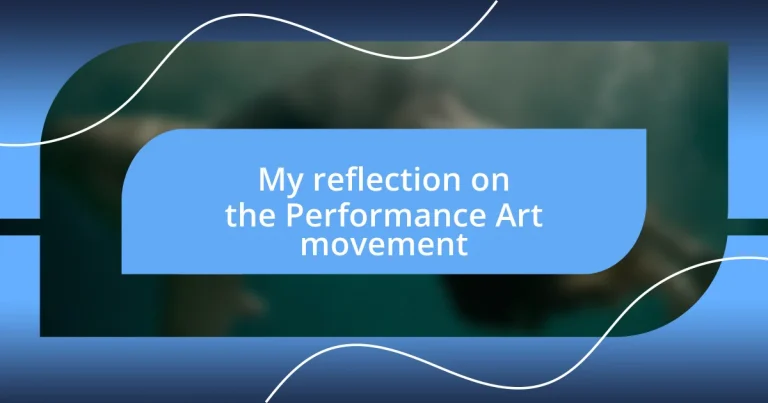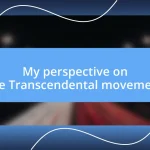Key takeaways:
- Performance art, rooted in early 20th-century avant-garde movements, evolved through political and feminist themes, leading to diverse expressions and global participation by the late 20th century.
- Key figures like Marina Abramović, Yoko Ono, and Chris Burden pushed boundaries, using their bodies and experiences to provoke thought and engage audiences in discussions about vulnerability and societal issues.
- Today, performance art challenges societal norms and addresses critical global issues, fostering community engagement and personal reflection in an increasingly digital world.

Understanding Performance Art
Performance art, at its core, is an exploration of human experience and emotion manifested through live action. Unlike traditional art forms, it invites the audience into the moment, blurring the lines between creator and observer. I remember attending a performance where the artist stood in silence for what felt like an eternity, and I found myself wondering about the weight of that stillness—what was conveyed in those quiet moments?
What strikes me about performance art is its ephemeral nature; once it’s done, it’s gone. This transient quality can evoke a deep emotional response, as I’ve often felt a bittersweet pang when realizing the experience isn’t something I can relive. Isn’t it fascinating how a fleeting moment can leave such a lasting impression?
I’ve often pondered the question: How does the artist’s body become a canvas, and how does movement express ideas that words sometimes can’t? In witnessing a live performance, I can feel vulnerability and boldness intertwining. This makes me appreciate how performance art serves as a powerful medium for personal expression, challenging both the artist and audience to engage on a deeper emotional level.

Historical Context of Performance Art
The development of performance art can be traced back to the early 20th century, with roots in Dadaism and Futurism. These avant-garde movements challenged traditional art norms, encouraging artists to explore action and spontaneity. I vividly recall visiting an exhibit where the chaotic energy of the Dadaist performances made me feel like I was stepping into a different reality—a whirlwind of surreal expression. It’s incredible how those early acts set the stage for what would blossom into performance art’s rich tapestry.
As I explored further into the 1960s and 1970s, I noticed performance art taking on political and feminist themes, significantly expanding its scope. Artists like Marina Abramović and Yoko Ono used their bodies as vessels of social commentary, often putting themselves in vulnerable or even dangerous situations. I remember watching a documentary that showcased Abramović’s intense work, “The Artist Is Present,” where her silent gaze ignited profound reflections among the audience—would I have the courage to be that exposed? That moment encapsulated how performance art became a platform for activism and personal storytelling.
The evolution continued into the late 20th and early 21st centuries, with technology merging into performance art, creating even more interactive experiences. I had the opportunity to witness a digital performance that incorporated live streaming, allowing global participation. It struck me how performance art has adapted and morphed, continually redefining its boundaries while making space for diverse voices. Isn’t it remarkable how a simple act of presence can transcend time and space, connecting us across cultures and generations?
| Era | Context |
|---|---|
| Early 20th Century | Influence of Dadaism and Futurism |
| 1960s-1970s | Political themes and feminism emerge |
| Late 20th-21st Century | Integration of technology and global participation |

Key Figures in Performance Art
Performance art has been shaped by numerous visionary artists, each bringing their unique perspective to this dynamic field. One standout figure is Marina Abramović, whose work often intertwines endurance and vulnerability, leaving audiences profoundly moved. I vividly recall the palpable tension in the air during her performance, where she sat silently across from participants, inviting them into an intimate exchange that felt as if time melted away.
Other key artists include:
- Yoko Ono: Known for her conceptual approach, Ono’s work invites audience participation, often pushing boundaries of societal norms.
- Joseph Beuys: He used his performances to address political and social issues, infusing his actions with personal narrative and symbolism.
- Chris Burden: His provocative and often dangerous performances, like “Shoot,” made a powerful statement about violence and mortality.
- Ann Hamilton: By incorporating text and sound into her work, she created immersive experiences that resonate on both intellectual and emotional levels.
Each of these artists has left an indelible mark on the performance art landscape, challenging both themselves and their audiences to confront uncomfortable truths. I can’t help but feel a sense of gratitude for the courage they exhibit, pushing the human experience into new realms of understanding.

Notable Performance Art Works
One of the most iconic works that immediately comes to mind is Chris Burden’s “Shoot.” In this daring performance, Burden had himself shot in the arm by an assistant. It struck me deeply when I learned about this piece not just for its shock value, but for the commentary it made on the nature of violence in society. What would possess someone to risk their life for art? Burden’s choice forced me to confront the extremes some artists are willing to go to evoke thought and emotion.
Then there’s Marina Abramović’s “Rhythm 0,” where she invited the audience to interact with her using an array of objects, some of which could inflict pain. I will never forget hearing participants recount their experiences afterward. They spoke about how the work allowed them to explore their own boundaries of morality and personal responsibility. It made me wonder—how far would I go in expressing my own desires if given the chance?
Another notable piece is Yoko Ono’s “Cut Piece,” where she invited audience members to cut away pieces of her clothing. I remember the palpable tension in the room as participants hesitated and then began to slice away. Watching it made me reflect on vulnerability and the power dynamics in social interactions. Would I have the courage to put myself in such a position? These works not only showcase the innovative spirit of performance art but also powerfully engage us in our own self-reflection.

Elements of Performance Art
The elements of performance art are incredibly diverse, often intertwining various disciplines such as theater, dance, and visual art. One fundamental aspect is the presence of the artist, who becomes an integral part of the artwork itself. I remember feeling an electric connection when witnessing live performances; the physicality of the artist, their gestures, and even their silence held a weight that a traditional canvas could never convey.
Another critical element is the space in which the performance occurs. It can be as simple as a stage or as complex as an entire city block transformed into a temporary gallery. I once attended a performance that took place in an abandoned warehouse, and the atmosphere amplified the sense of urgency and rawness. The environment not only informed the piece but also enveloped the audience in a cocoon of emotion, making the experience unforgettable.
Audience interaction also plays a vital role in performance art. It’s fascinating how the presence and actions of the audience can shift the dynamics of a piece dramatically. I often find myself pondering how my own reaction would shape the work if I were part of it. Can we truly appreciate the art without engaging in it, or does our participation elevate its significance? These elements collectively create a unique discourse that challenges both the artist and the viewer.

Impacts of Performance Art Today
The impact of performance art today is profound, reaching across various cultural and social landscapes. For instance, when I encountered a modern performance that addressed climate change, I was moved by how the artist vividly illustrated our collective responsibility. It made me question my daily habits—are my choices contributing to the problem or helping to solve it? The blend of personal narrative with a global issue made the art resonate deeply, showcasing how performance can spark urgent conversations.
Moreover, performance art today often challenges societal norms and pushes boundaries. I recall watching a piece that addressed gender identity and fluidity, which forced me to rethink preconceived notions of gender roles. As I observed the artist’s raw expression and authenticity, I felt a mix of empathy and discomfort. This emotional response is crucial; it not only broadens our understanding but also compels us to reevaluate our beliefs about identity in today’s context.
In a world where digital experiences seem to dominate, the immediacy of live performance art remains irreplaceable. I vividly remember attending a site-specific performance that unfolded in a public space; the spontaneity drew in unsuspecting passersby. As they paused to witness the unfolding drama, I sensed a shared connection among the audience, a beautiful reminder of how art can interrupt our daily lives and foster community. Isn’t it fascinating how these moments can ignite dialogue and empathy among individuals who might never cross paths otherwise?














